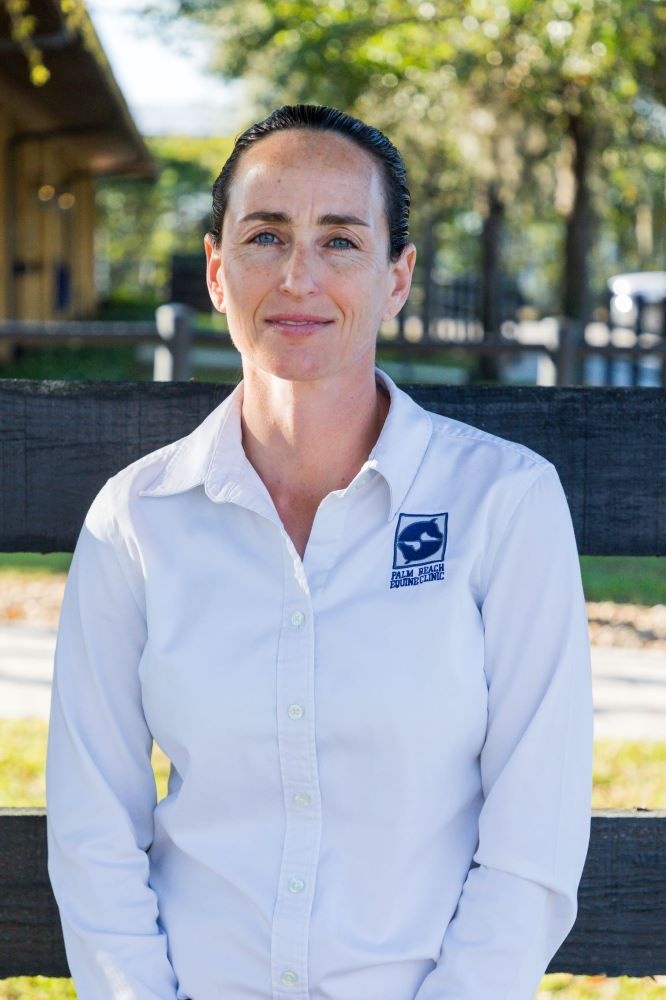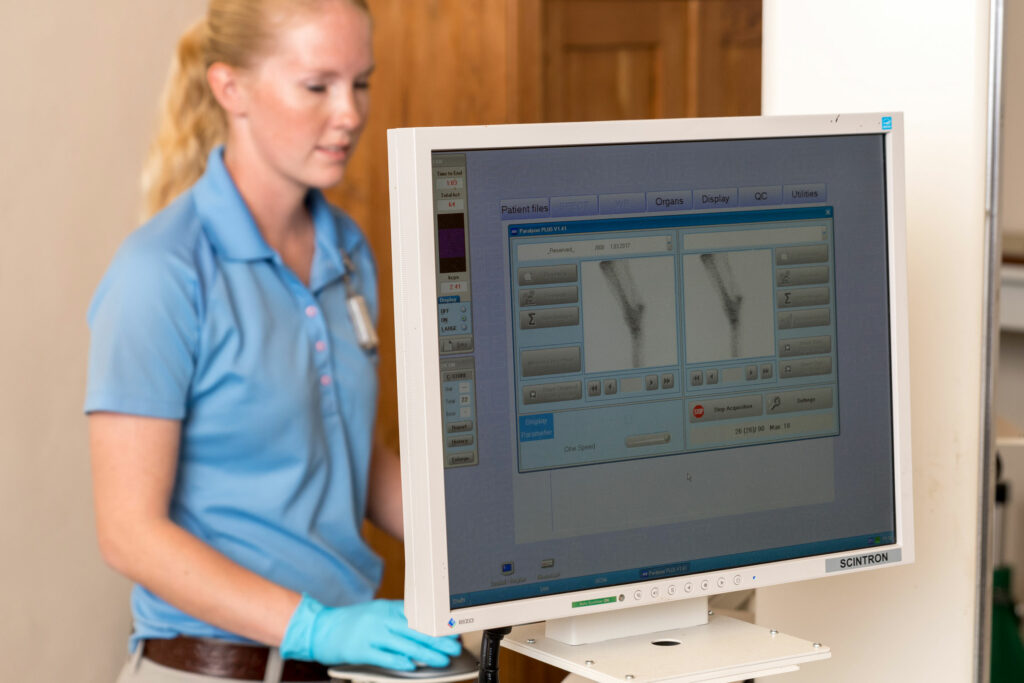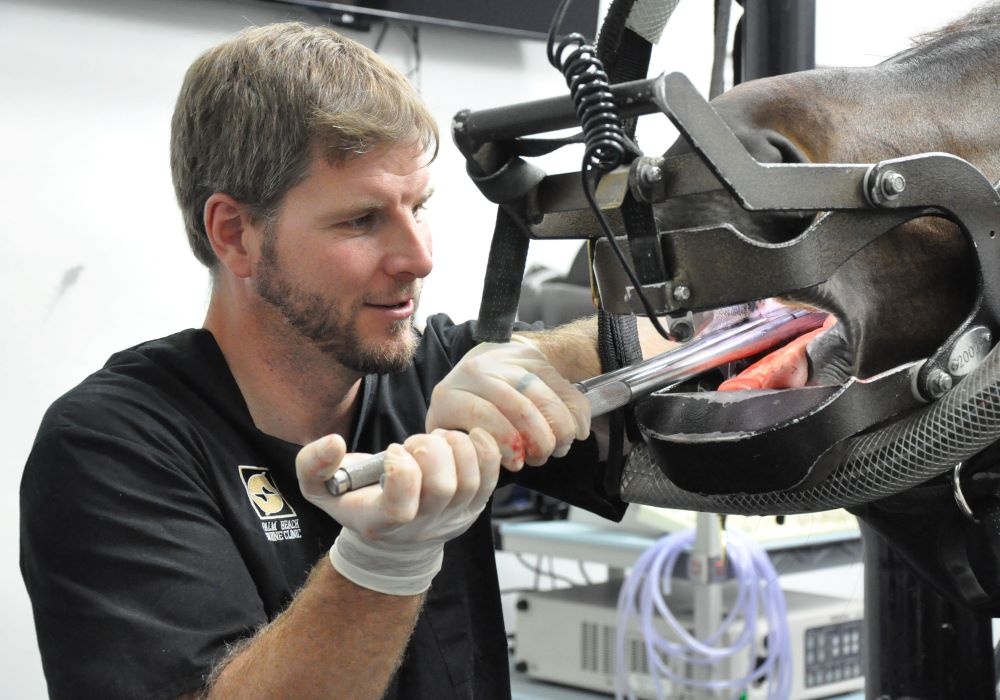Category: Medical
Palm Beach Equine Clinic of Wellington, FL, is a worldwide leader in sport horse medicine and emergency colic care. While symptoms of colic should be treated medically first, surgical intervention can be necessary, and the team at Palm Beach Equine Clinic is prepared for every situation.
With three Board-Certified Surgeons on staff, as well as a state-of-the-art hospital and the most advanced surgical equipment, Palm Beach Equine Clinic has a very high success rate in saving horses from life-threatening colic. The veterinarians take pride in their equine clients returning to full intended use and continuing to perform at their highest levels.
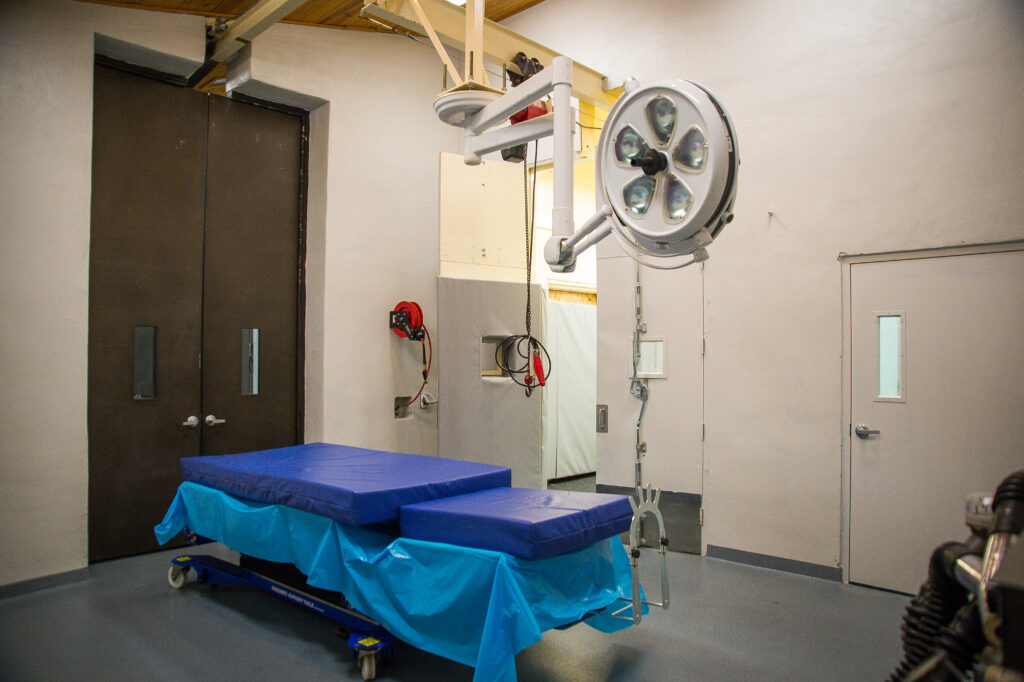
Causes and Symptoms
Colic is defined as any source of abdominal discomfort in the horse. Abdominal pain or problems within the gastrointestinal tract can arise unexpectedly from many different origins, including but not limited to: spoiled feed, abrupt changes in feed, parasite infestation, sand ingestion, lack of water consumption, excess stress, or changes in the weather. Many times there is not a well-defined inciting cause.
The most important step any owner can take is to recognize the symptoms as early as possible and immediately call their veterinarian. Pawing, rolling, looking at the abdomen, sweating, loss of interest in food and water, and absence of gut sounds in any of the four quadrants are common symptoms. The sooner the veterinarian gets involved in treatment, the better the horse’s chance of survival.
In the event of an emergency, the surgeons and veterinarians of Palm Beach Equine Clinic are available 24/7. When an equine patient is admitted to the hospital, every step is taken to quickly diagnose the problem and correct it immediately.
Tests and Diagnosis
Board-Certified Surgeon Dr. Weston Davis explained that one of the biggest challenges in the sport horse population is determining surgical versus non-surgical colic cases.
“We do not want to put a non-surgical case through the risk of anesthesia and the months of healing time, so we try to spare that at all costs and determine the surgical cases as accurately as we can,” Dr. Davis detailed. “On the split side of that, we try to operate as quickly as possible on any horse that needs surgery and not miss any surgical lesion types.”
There are several methods for differentiating surgical cases. Simple physical exam findings, such as the color of the gums, heart rate, gut sounds, and level of pain can all be supportive of surgical necessity. A variety of tests may also include abdominal ultrasounds and rectal exams.
An Abdominocentesis (or belly tap) is performed on every questionable colic case, where fluid is collected from around the intestines and analyzed for color and character. A variety of other laboratory tests will be run on the fluid as well, with the aim of quickly determining if the horse’s bowel is compromised.
Surgical Procedures
If surgery is necessary, there are a few different approaches that may be performed depending on the specific case.
For chronic colic cases, such horses with longstanding, intermittent colic, an abdominal exploratory procedure may be done with laparoscopy. This option can be done with the horse standing and is a minimally invasive way to examine the full abdomen.
In most acute cases, further steps must be taken. If the veterinarian determines that the horse is a surgical candidate, the patient will go under general anesthesia. The surgeons try to make as small of an incision as they can to perform the needed surgical correction.
“If we intervene early, we can take a strangulating or compromised lesion – one that most people understand as a twist – and we can go into the abdomen and correct the twist, reposition everything appropriately, explore the remainder of the abdomen to make sure nothing else is going on, and then close them up,” Dr. Davis explained. “Some of these surgeries can be as quick as 30 minutes and require just an untwisting, repositioning, and closure. The ones that are bad are the usually the cases that have a more severe twist or have been going on longer.”
In more severe or long-standing cases, the surgery can require a resection and an anastomosis procedure to excise a compromised or devitalized segment of the intestine. The surgeon then joins the healthy ends back together.
“Even more advanced procedures would be like a re-plumbing of the intestines,” Dr. Davis noted. “One of the most common examples of this would be a patient with damage to the end of the small intestine, near or involving its junction with the cecum. In a case like this, we would perform a ‘jejunocestomy’ where we join another part of the small intestine to a different position on the cecum.”
Post-Operative Recovery
After any surgery, there is a process of recovery, which Palm Beach Equine Clinic makes as easy as possible for its clients. In the traditional recovery, most horses will remain in the hospital for a few days. In the post-operative period, they generally receive fluids until they are ready to eat and drink, 3-5 days of antibiotics, and 5-7 days of anti-inflammatories.
“The recovery process is highly dependent upon how sick they are after surgery,” Dr. Davis stated. “Some horses will bounce back and be home 48 hours later, but a very sick horse could potentially spend seven to ten days in the hospital until they are healthy enough to get off fluids and go home.”
After leaving the hospital, the horse is usually placed on one month of stall rest, followed by another month of turnout in a small paddock. In between eight to 12 weeks, the horse will usually be fully recovered and ready to start back to work.
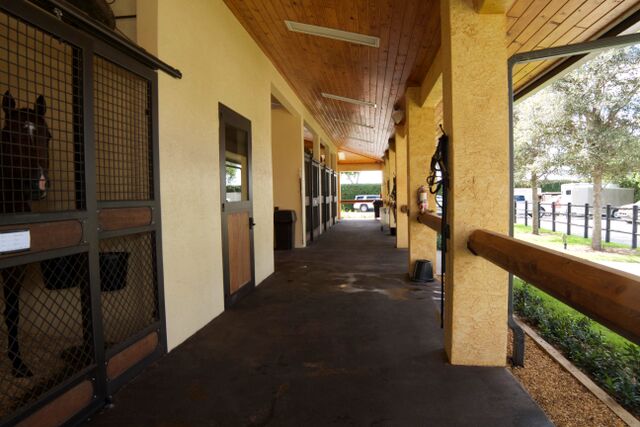
Physical Therapy
With the sport horse in mind, PBEC pays special attention to the health of the abdomen following surgery. The health of the abdominal incision and prevention of infection or hernias is very important. In most cases, the surgeon will recommend physical therapy and special exercises to re-strengthen the horse’s abdominal muscles so that it can get back to work quickly and have a strong abdominal musculature when it does.
“Making the horse walk backwards is one thing that will make them tighten and work their abdominal musculature,” Dr. Davis shared. “Pinching or tickling around their tail head is another common exercise to make them do something similar to a stomach crunch.”
As one of the top equine emergency care centers in the world, Palm Beach Equine Clinic is prepared to handle any case, 24 hours a day, seven days a week, and 365 days a year.
“With the combination of quick surgical intervention, excellent surgical care, and specialized post-operative measures, Palm Beach Equine Clinic has a very high rate of return to athletic performance for all of our colic cases,” Dr. Davis concluded.
Palm Beach Equine Clinic provides experience, knowledge, availability, and the very best care for its clients. To find out more, please visit www.equineclinic.com or call 561-793-1599.
Several regions across the U.S. have reached the peak of the winter show season, and with the increase in equine travel, as well as large populations of horses in close contact with one another, proper vaccination protocols are as important as ever.
Dr. Kathleen Timmins of Palm Beach Equine Clinic in Wellington, FL, is often asked why proper equine vaccination protocols are imperative for all horses, and her answer voices directly to the welfare of the horse.
“You could save your horse’s life!” she said. “It is really important from an infectious disease standpoint, but also for mosquito-borne diseases or rabies; these are diseases that are life-threatening for lack of a $25 vaccine.”
Vaccinations: When, What, and How
According to Dr. Timmins, recommended vaccination protocols vary by vaccine and by the location of the horse, but the core group of vaccines is relatively standardized. As a rule, horses should receive vaccines to prevent mosquito-borne diseases like Eastern Equine Encephalitis (EEE), Western Equine Encephalitis (WEE), and West Nile Virus twice a year. Equine Encephalitis is characterized by the swelling of the brain in an infected horse, while West Nile Virus infects the central nervous system and may cause signs of Encephalitis, including those ranging from fever to weakness and paralysis of the hind limbs.
“Vaccinations against mosquito-borne diseases become very important in south Florida because we have mosquitoes year-round,” said Dr. Timmins. “As you go further north, owners may sometimes choose to only vaccinate against those once a year.”
Included in the twice-a-year vaccination program is a Flu/Rhino dose. Flu vaccination prevents the illness in horses much the same way it does in humans, while the Rhino vaccine is key in helping to prevent the Equine Herpesvirus (Rhinopneumonitis). Equine herpesvirus type 1 (EHV-1) and Equine herpesvirus type 4 (EHV-4) most commonly result in respiratory disease in horses and can progress to neurological disease.
East and West Equine Encephalitis, West Nile, and Flu/Rhino can all be administered as a combination vaccine requiring only one injection.
In addition to vaccinations given twice a year, annual vaccinations include those to prevent Potomac horse fever, a potentially fatal illness that affects the digestive system and is caused by the intracellular bacterium Neorickettsia risticii; Strangles, a bacterial infection of the upper respiratory tract; and Tetanus, an acute, often fatal disease caused by the bacteria Clostridium tetani found in soil.
Much like the vaccinations administered to humans, the companies that produce the vaccines are in constant transition, adapting each vaccine to the most common strains to ensure the most accurate prevention of disease.
The Role of the Horse Show

To combat the rise of infectious disease outbreaks, many horse show organizers have taken a proactive step to reduce the spread of disease by developing vaccination requirements for the show grounds. This is a step towards preventing disease as an organized community, according to Dr. Timmins.
“No one wants sick horses,” she said. “All horse show organizers can do is put the requirements out there and hope that people comply and that they understand why vaccinations are so important.
“When a horse pops with a fever at a show everyone is alarmed,” continued Dr. Timmins. “If proper vaccination protocols are followed, it is easier for us to figure out why that horse has a fever and treat them quickly and appropriately.”
Negative Reactions
There are occasional cases of horses reacting negatively to certain vaccinations, making a regular schedule difficult. After receiving a vaccine intramuscularly, some horses experience local muscular swelling and soreness or signs including fever, anorexia, and lethargy. Severe reactions such as anaphylaxis can also occur in rare, extreme cases.
According to Dr. Timmins, there are procedures in place to help keep horses that suffer reactions on a systematic vaccination plan without threatening their health or competition schedules.
“What I will do first is break up the vaccinations so we can figure out which one is bothering the horse,” said Dr. Timmins. “Then sometimes all it takes is a change in the vaccine company because the particular horse is reacting to their preservative or their carrier. Veterinarians can also pretreat with a nonsteroidal anti-inflammatory drug to avoid really bad reactions. Finally, there is always an option to administer intranasal vaccines rather than using an injectable.
“Very few horses have severe reactions to vaccines and for the most part, the horses traveling to shows are part of a young and healthy populations,” continued Dr. Timmins.
As the winter horse show season continues throughout the U.S., horse health must be a priority and vaccinations are a simple way for the equine community to do their part.
“Vaccinations are an easy and relatively inexpensive way to prevent infectious disease outbreaks, and keep our horses healthy and safe,” she said. “There’s just no reason not to vaccinate.”
More About Dr. Timmins

Dr. Kathleen A. Timmins is a 1993 graduate of the Ohio State University School of Veterinary Medicine. She completed her internship in equine medicine and surgery at the Illinois Equine Hospital near Chicago. Prior to coming to Florida, Dr. Timmins practiced in Aiken, South Carolina, where she met her husband, John, who plays polo professionally. Growing up in Central Ohio, Dr. Timmins began her relationship with horses as a child on the hunter/jumper circuit. She continues to ride and show as much as possible. She and her husband are enjoying parenthood with their daughter Schuyler.
Palm Beach Equine Clinic provides experience, knowledge, availability, and the very best care for its clients. Make Palm Beach Equine Clinic a part of your team by calling 561-793-1599.
Palm Beach Equine Clinic in Wellington, FL, has state-of-the-art surgical and advanced diagnostic imaging equipment available. With board-certified Radiologist Dr. Sarah Puchalski, Palm Beach Equine Clinic uses the Equine Standing Magnetic Resonance Imaging (MRI) and a Nuclear Scintigraphy (bone scan) camera to quickly and accurately diagnose injuries for their clients.
Every horse owner dreads seeing signs of lameness or discomfort in any horse, whether it is a backyard companion or a top-caliber sport horse. For performance horses, however, one of the first questions many owners ask upon contacting a veterinarian about a problem is, ‘Can the horse safely and comfortably return to work?’ Using Palm Beach Equine Clinic’s cutting-edge technology, Dr. Puchalski can quickly and accurately answer that question.
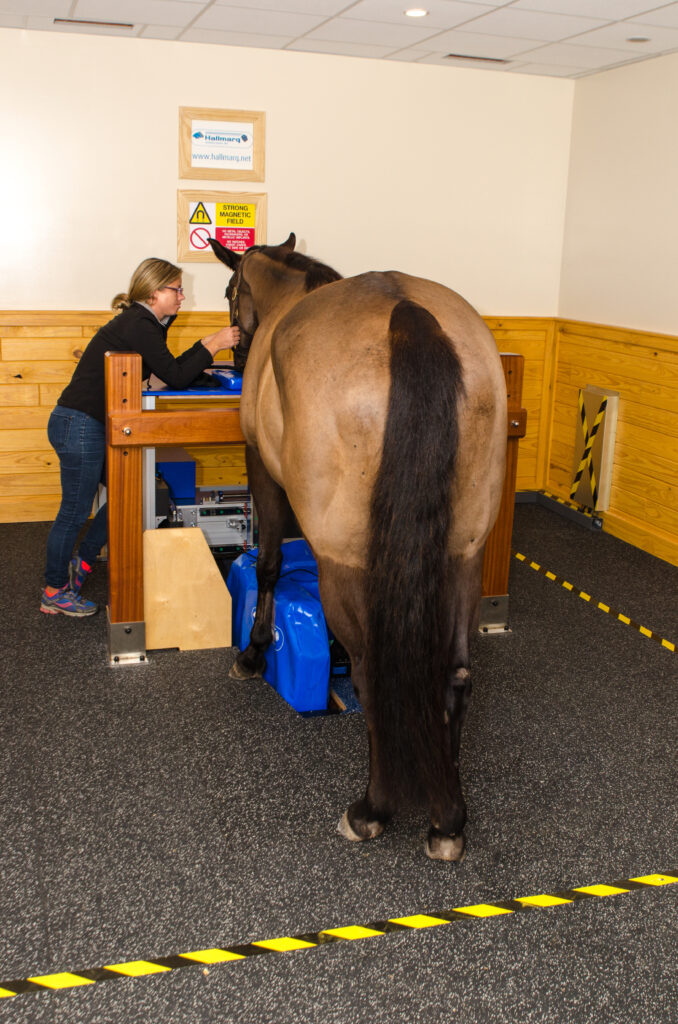
The Equine Standing MRI produces highly detailed images in several different planes to capture a complete image of a desired area. An MRI is best used to further define a specific area of both bony or soft tissue that has been pinpointed as the origin of lameness. The process can be completed while the horse is in a standing position and requires only light sedation.
Similarly, the process of Nuclear Scintigraphy (bone scan) begins with the injection of a radioactive isotope, specifically named Technetium 99. The isotope attaches to the phosphorous proteins localized within the bone and is absorbed over a few hours’ time. A specialized nuclear isotope gamma ray camera is used to capture images of the skeletal anatomy with a 360-degree view. Points of interest “light up” on the image to indicate increased metabolic activity and the site of injury.
Lameness or performance problems are most frequently approached through routine x-rays and ultrasounds, which can appear normal. Thus, it is difficult to diagnose subtle problems because the most common tools are not sensitive enough to diagnose in every case. At PBEC, the Equine Standing MRI and Nuclear Scintigraphy equip veterinarians with an advantage when troubleshooting a lameness issue and helps them to determine a correct, quick diagnosis.
Coupled with advanced technology, Palm Beach Equine Clinic is also one of very few equine practices in the U.S. with a Board Certified Radiologist on staff, and thanks to Dr. Puchalski, hundreds of MRI and bone scans are read each year at Palm Beach Eqine Clinic. In addition to state-of-the art diagnostic tools, the technology also affords economic benefits to owners.
“MRIs can give a definitive diagnosis, and that saves time and money in the long run,” said Dr. Puchalski. “For example, if a horse goes lame and is examined and treated empirically, which is a diagnosis based on likely problems through common diagnostic procedures, it either stays sound or it becomes lame again or even non-functional in three to six months. This method sets back the commencement of the appropriate therapy.
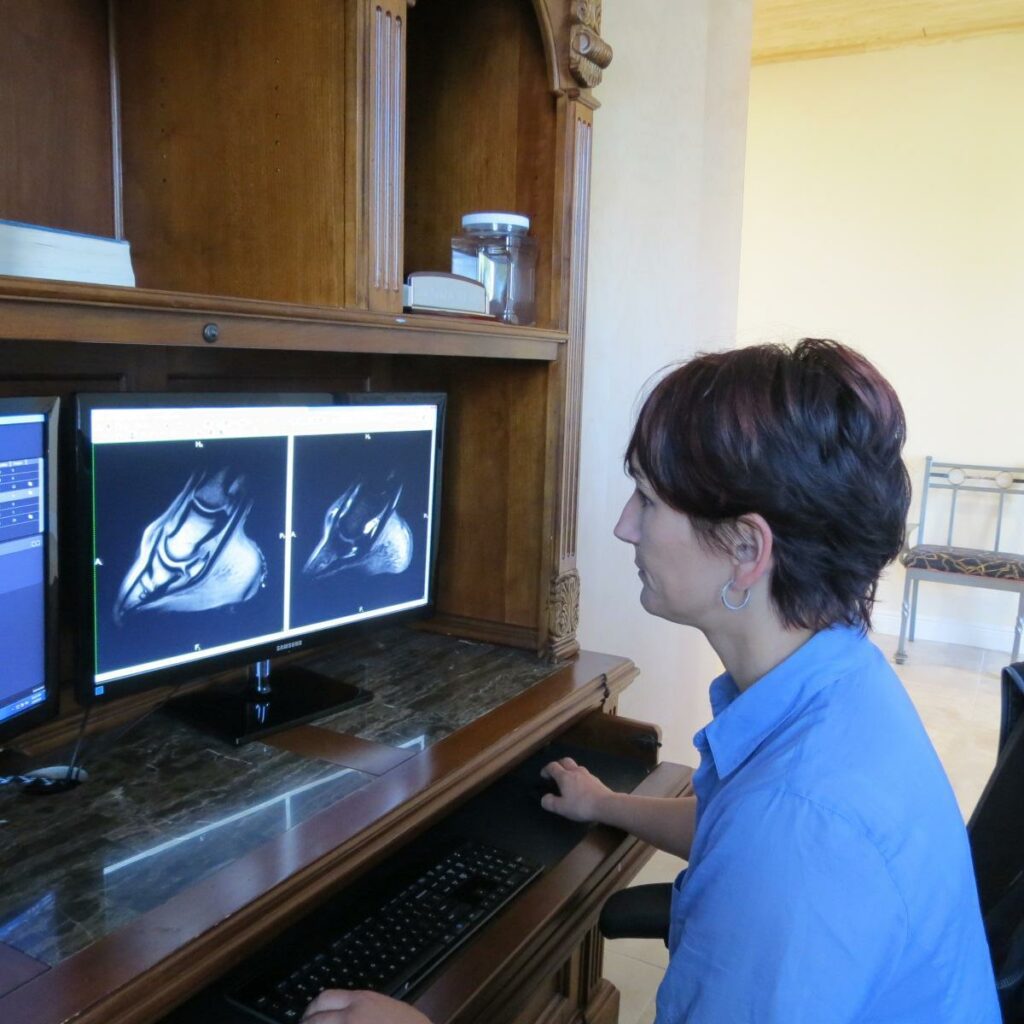
“What the MRI does is allow the horse to be treated early and correctly,” continued Dr. Puchalski. “Otherwise, you may not be treating the correct issue, and the horse could end up lame again very soon.”
Nuclear Scintigraphy does not produce a scan that is as specific, but it gives Dr. Puchalski the opportunity to procure a concrete quick diagnosis, as well as evaluate the whole horse for secondary problems.
“Oftentimes the primary problem in one place is making a horse sore in other places,” she said. “Owners like to know the root problem, but to also quickly diagnose secondary problems so the entire horse can be treated at once.”
As the official veterinary hospital of the Winter Equestrian Festival (WEF) and the Adequan® Global Dressage Festival (AGDF), Palm Beach Equine Clinic sees a high concentration of sport horses in need of care. In turn, owners of those horses are eager to see their horses quickly and happily return to competition.
“The biggest benefit to Palm Beach Equine Clinic and the Wellington community as a result of these MRI and Nuclear Scintigraphy scans is accessibility,” concluded Puchalski. “Anyone can call from the horse show to the clinic, get a scan scheduled quickly- in and out, get results fast, and then their training program can be changed immediately.”
About Dr. Sarah Puchalski
Dr. Sarah Puchalski is from Davis, CA, where she was an associate professor at the University of California in their Department of Surgical and Radiological Sciences. In 1995, she received her BS in biology from Simon Fraser University in British Columbia, and in 1999 earned her Doctor of Veterinary Medicine from the University of Saskatchewan in Saskatoon, where she received the ACVS Outstanding Large Animal Surgery Student award that same year. Dr. Puchalski interned in Field Service and Sports Medicine at New Bolton Center at the University of Pennsylvania in 2001, and completed her residency in radiology at UC Davis in 2005.
Dr. Puchalski has devoted her career to teaching and improving equine health through the development and refinement of diagnostic techniques. In 2011, she contributed to two books on the topic of equine lameness. Her recent contributions include chapters in “Diagnosis and Management of Lameness in the Horse,” edited by Ross and Dyson, as well as in “Veterinary Computed Tomography and the Clinical Veterinary Advisor: The Horse, Equine Colic and Veterinary Clinics of North America.” She also has contributed close to 50 scientific articles concerning the diagnosis of equine lameness to many periodic journals, including Veterinary Radiology & Ultrasound: the official journal of the American College of Veterinary Radiology and the International Veterinary Radiology Association; Veterinary Pathology; Equine Veterinary Journal; the American Journal of Veterinary Research; Equine Veterinary Education; Journal of the American Veterinary Medical Association; and Journal of Veterinary Internal Medicine.
Palm Beach Equine Clinic provides experience, knowledge, availability, and the very best care for its clients. Make Palm Beach Equine Clinic a part of your team!
Shipping fever is a respiratory disease complex associated with the transport of horses. A common scenario for shipping fever is when a horse is transported from its barn to another state to attend a show. The horse may be healthy and well-hydrated before entering the trailer, but the stress of travel can weaken the immune system.
Another leading factor is tying a horse’s head up while trailering long distances. The mucociliary apparatus of the trachea, which clears dirt and debris from the lower airway, is interrupted due to dehydration, change in temperature, and the inability of the horse to lower its head. The introduction of foreign material into the lower airway can lead to pneumonia, fluid in the pleural cavity (surrounding the lungs), and associated respiratory distress.
Signs and Symptoms to Watch For
Common symptoms noted are hyperventilation, increased rectal temperature, coughing, and nasal discharge after travel. The horse may seem depressed, not willing to work, and not interested in food or water. It is important to call the vet immediately if any of these symptoms are observed after a horse travels. The faster an infection in the lower airway is treated, the quicker and more likely the horse can recover. Shipping fever, if left untreated, can lead to severe pleuropneumonia, which can be life-threatening.
Treatment of Shipping Fever
Initial treatment includes antibiotics, anti-inflammatories, and hydration. If pneumonia progresses without treatment, surgery may be indicated, which can include removal of a rib and placement of chest drains (to drain fluid around the lungs). The vet should be called, and it is crucial to begin treatment at the earliest sign.
There are several preemptive steps that can be implemented to reduce the risk of a horse developing respiratory disease related to travel:
- Split up long trailer rides over several days. Be sure to take breaks and let horses out of the trailer at least every 6-8 hours, if possible.
- Ensure the horse is properly hydrated before travel. Common preventative practice includes administration of oral or IV fluids by a veterinarian prior to travel.
- Discontinue any immunosuppressant drugs 48 hours prior to travel. This includes steroids such as dexamethasone.
- Ship horses in a box stall or similar enclosure so their heads do not have to be tied during travel.
- Ask a veterinarian about immunostimulant drugs that can be given prior to travel.

As more and more international-level sport horse competitions are brought to North America, the import and export of equine athletes overseas has increased significantly. Moreover, with the winter show season in Florida, horses from around the world are about to make a pilgrimage to South Florida.
Either for a purchase or regularly scheduled show-season travel, Dr. Jordan Lewis of Palm Beach Equine Clinic works with Florida state veterinarians to simplify the process of importing and exporting horses to and from international destinations.

Where to Begin
The transport process begins with obtaining travel documents, including an equine passport and health certificate, and organizing travel arrangements with a professional equine shipper. Once travel is organized, checking the horse’s health is suitable for traveling is always the top priority.
“The most important thing to have in order is health records, up-to-date vaccinations, and complete preventative care,” said Dr. Lewis. “Much of the testing upon import and export depends on the outbreaks of different diseases in the import and export countries. The requirements change year to year and even month to month.”
Dr. Lewis is one of the many veterinarians at Palm Beach Equine Clinic who helps owners navigate through the ever-changing import, export, and quarantine regulations.
Requirements Differ Depending on the Specific Import and Export Countries
“Most horses that are coming from Europe to the U.S. to compete in Florida fly into Miami and are placed in a two- or three-day U.S. Department of Agriculture (USDA) quarantine depending on the country they are arriving from,” said Dr. Lewis. “If they are arriving from South America, however, requirements are different and they will spend seven days at USDA in Miami.”
It is there that the most current regulations are upheld and tests are performed to rule out the presence of any threatening diseases.
When importing to the U.S., Dr. Lewis affirms that many tests are required through bloodwork, including equine infectious anaemia (EIA) or coggins; piroplasmosis, which is a tick-borne disease; glanders, a common bacterial disease; and dourine, a parasite-born venereal disease. When traveling from South America, horses are also tested for other parasites, such as screw worms. When exporting from the U.S., testing will vary based on the regulations of the destination country, its current health precautions and common parasites or diseases.
CEM Quarantine
Once the initial quarantine is complete, geldings are released into the general population, while stallions and mares are transitioned to Contagious equine metritis (CEM) quarantine at either a commercial or private quarantine facility.
CEM is a venereal disease in horses caused by bacteria and is only spread during breeding or through infected semen during artificial insemination. CEM quarantine is recommended for all horses entering the U.S. from Europe, but not necessary for those flying in from South America as the disease is not present in those countries.
According to Dr. Lewis, CEM quarantine takes about 15 days for mares and 35 to 40 days for stallions. Taking this into account, she recommends owners plan a month to complete the travel regulations for a mare and two months for a stallion. Horses that are continually showing obviously don’t have this time built into their travel schedules, and that is where waiver tents enter the equation.
Mares and stallions that bypass CEM quarantine are shipped in a sealed trailer to the competition facility where they enter quarantine in a waiver tent to keep them secure from the general horse population while competing.
If horses are admitted into a traditional CEM quarantine, veterinarians like Dr. Lewis perform the appropriate tests and cultures that clear a horse for approved release into a new home or to the event.
“We work very closely with state veterinarians to do all the blood draws and testing for imported horses, as well as stay on top of the requirements of export countries so each horse can easily and safely transition into the equine population,” said Lewis.
While requirements may change often, the ultimate goal of veterinarians like Dr. Lewis and her colleagues remains the same: releasing safe, healthy, and happy horses to travel into the U.S. and all countries around the world.
Horses are competing around the world more than ever. It is important for all horse owners to implement a routine for vaccinations and biosecurity protocols to keep their horses healthy. Many infectious diseases are easily transmitted between horses and spread quickly through a stable or showground if the proper measures are not taken. The veterinarians at Palm Beach Equine Clinic are very experienced with isolation cases and always available to discuss the important steps that should be taken to maintain effective biosecurity protocols. Palm Beach Equine Clinic encourages owners to reach out to their veterinarians at any time for more information or alert doctors of a suspected potential risk.
Preventative Equine Healthcare
The best first line of defense for horse owners is to maintain current equine vaccinations. Equine Influenza and Equine Herpes Virus (EHV-1) are two deadly diseases that are highly contagious and should always be included in a routine vaccination program. In the United States, it is now required for all horses attending a USEF competition to be vaccinated for Equine Influenza and EHV-1 prior to any event. Official documentation of vaccinations being administered within the previous six months must accompany the horse to the competition.
Vaccination does not guarantee absolute protection against any diseases, and biosecurity measures should also be taken as added protection.

Biosecurity is a preventative measure taken to reduce the risk of transmission of infectious diseases by people, animals, equipment, or vehicles. Biosecurity is important at all times, even when an outbreak has not occurred.
The Stress of Travel
Owners that use commercial transport for their horses should confirm that the trailers have been disinfected between each shipment. Trailers should always be well ventilated, and horses should be provided with fresh, clean water at all times. The stress of travel can decrease a horse’s immune system, causing more vulnerability to disease. It is important to monitor your horse’s behavior and health closely before, during, and after traveling.
Preventing the Spread of Diseases
Simple day-to-day practices in health care and hygiene are also very important in reducing the risk of contracting an infectious disease. Washing hands between grooming horses and regularly cleaning grooming supplies can reduce the spread of infection. When attending a horse show or moving horses to a new location, a footbath for all persons entering or leaving the barn at each doorway can be effective in disinfecting shoes to reduce tracking disease into the barn. If horses are showing a depressed attitude, have stopped eating, are running a fever, and/or have a runny nose, contact your veterinarian immediately. Early medical attention for an infectious disease makes a large impact on the recovery of your horse and the equine community’s safety.
The best way to safeguard any horse’s health is to keep the immune system strong with support from a suitable nutrition and exercise program. Vaccinations, a proper deworming program, and biosecurity practices will provide additional protection.
Palm Beach Equine Clinic prides itself as being a consistent leader in sport horse medicine and continues to expand the diagnostic imaging technologies to provide the best services for clients. In addition to state-of-the-art imaging technology available on-site, Palm Beach Equine Clinic is fortunate to work directly with world-renowned Board Certified Radiologist Dr. Sarah Puchalski.
Dr. Sarah Puchalski is a Diplomate of the American College of Veterinary Radiology whose specialty includes the interpretation of diagnostic imaging including Radiographs, MRIs, Nuclear Scintigraphy, and CT scans. Dr. Puchalski’s job requires a high level of specialization to properly review imaging to produce comprehensive written reports for referring veterinarians. In addition to her full-time position with PBEC, Dr. Puchalski reads imaging cases for clinics all over the world. Many veterinarians and owners request a consultation as a second opinion on Pre-Purchase examinations radiographs and ultrasound evaluations.
Pioneering Equine Diagnostic Imaging Modalities
Palm Beach Equine Clinic has always been a pioneer in advances of technology within the equine veterinary industry. Almost 30 years ago, Palm Beach Equine Clinic bought the first ultrasound for equine practice in South Florida. Twenty-five years ago, Palm Beach Equine Clinic installed the first Nuclear Scintigraphy gamma ray camera to perform bone scans. Twenty years ago, Palm Beach Equine Clinic assisted in developing Computed Radiography (CR) for horses. Currently, Palm Beach Equine Clinic has the most advanced surgical and diagnostic imaging equipment available, including a standing MRI unit, MiE gamma ray camera, Digital Radiography, Video Endoscopy, and a bevy of additional diagnostic equipment.
“Palm Beach Equine Clinic has a great case population and great equipment, which is a huge bonus for someone doing what I do,” Dr. Puchalski stated. “The equipment is exceptional, the technical staff is excellent, and the case population of the region is obviously amazing.”
Nuclear Scintigraphy Imaging
Palm Beach Equine Clinic proudly offers an updated Nuclear Scintigraphy lab (bone scan) that houses the MiE Nuclear Scintigraphy gamma ray camera. Nuclear Scintigraphy is typically used to diagnosis injuries or bone remodeling within the skeletal anatomy of the horse. This specialized camera is equipped with sharper contours for precise imaging that results in accurate lameness diagnoses. Advanced software provides the ability to acquire high quality images despite small movements from the patient. This feature reduces the time required to complete a study, which provides quicker results.
Bone scans are also very useful in defining multi-limb lameness origins for the hard to diagnose, long-duration lameness cases. Typically, Nuclear Scintigraphy scans isolate points of injury to be identified further with other diagnostic techniques, such as digital radiology and magnetic resonance imaging (MRI).
The clinic offers an MRI lab containing the innovative Equine Standing MRI manufactured by Hallmarq, which scans the equine distal limb in a standing position requiring only light sedation. MRI is very useful to further define a suspected lameness origin by acquiring more defined images of boney and soft tissue structures.
Regular, routine veterinary care is important to maintaining optimal equine health. Dental care, vaccinations, deworming, and annual physical examinations keep horses healthy and can identify problems early. It is very important that horse owners have a veterinarian who is familiar with their horses and provide routine care.
At Palm Beach Equine Clinic, every veterinarian values the importance of preventative equine medicine, and some have taken a specialty to treatments, including equine dentistry.
Equine Dentistry
Proper dental care is essential to the well-being and peak performance of every horse. Dental maintenance keeps horses working well, performing well, and most importantly, eating well.
It is important to get the horse’s teeth examined and regularly floated at least once a year and sometimes more frequently in older horses. The veterinarians of Palm Beach Equine Clinic are available to visit clients at their farms to perform thorough dental evaluations and “float” the teeth – a term that refers to the veterinarian wearing down the surface of the teeth, usually to remove sharp points or balance out the teeth in the mouth. During the routine examination, the veterinarian will also look for any other dental problems that the horse may have, such as a tooth abscess.
Regular dental care may help to prevent premature tooth loss and promote more complete utilization of feed. A horse with uneven teeth due to wear and tear is going to poorly grind up food creating issues with digestion. This could lead to colic, choke, or other serious complications. Sharp or uneven teeth can also cause pain due to the misfit of a bit on uneven teeth and contribute to poor performance or misbehavior. These problems can quickly be alleviated and prevented with proper care.
With Palm Beach Equine Clinic’s advanced technology, the veterinarians are able to perform more cutting-edge, specialized treatments beyond routine dentistry. Veterinarians are able to perform tooth extractions as needed for horses suffering from a tooth abscess or fracture. With the surgical staff at Palm Beach Equine Clinic, which includes three board-certified surgeons, dental surgeries, sinus surgeries, or similar procedures are easily performed at the clinic.
Preventative Equine Medicine
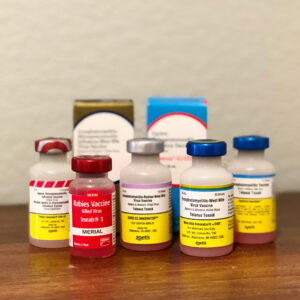
Along with dental care, Palm Beach Equine Clinic offers further preventative equine medicine, including worming protocols for parasite control and routine vaccinations.
Palm Beach Equine Clinic strongly suggests a fecal test to evaluate your horse’s internal parasite count on a routine basis. In Florida, the peak worm season is year-round due to the lack of frost. The effectiveness of different dewormer products can be measured using a simple fecal egg count reduction test, which involves performing a fecal test before and after deworming your horse. Equine tapeworms are also difficult to identify in fecal examinations. Deworming for tapeworms is strongly recommended annually with a product containing Praziquantel.
Establishing an effective deworming program for equine parasites has become an open topic for discussion on which method is most effective. Veterinarians have changed their views on worming in recent years, noting that minimal parasite load within the horse’s hind gut is actually helpful in producing a natural immunity; however, it is crucial to control the parasitic load.
Environmental management is imperative to equine parasite control. Due to the emergence of new resistant parasites, preventative measures in proper barn management should be added to routine rotational treatment with anthelmintic medications to properly control parasite exposure.
Protecting Your Horse from Infectious Diseases
Palm Beach Equine Clinic also stresses the importance of vaccinating horses against infectious diseases, especially with horses that travel. Highly contagious diseases such as Eastern Equine Encephalitis (EEE), the Equine Herpes Virus (EHV-1), and the West Nile Virus are just a few illnesses that often result in equine fatalities and should be taken very seriously.

Routine vaccinations are imperative to protecting horses from disease and are also a requirement to attend many horse shows. Palm Beach Equine Clinic can prepare horses for travel, whether within the U.S. or going to or from Europe.
The best defense for horse owners is to maintain current equine vaccinations to protect their horses. Vaccinating at the proper time of the year is critical, and boosters should be given regularly. Consult with your veterinarian for further guidance on when and how frequently different vaccinations should be administered.
Whether it is a top-level show horse or a backyard pet friend, the veterinarians of Palm Beach Equine Clinic are here to help with all maintenance needs. For questions or more information, please call Palm Beach Equine Clinic at 561-793-1599.
Palm Beach Equine Clinic is proud to have beneficial consulting relationships with many equine medical professionals throughout the country, including Dr. Stephen E. O’Grady, DVM, MRCVS, of Virginia Therapeutic Farriery. Dr. O’Grady provides advanced services in equine podiatry, offering comprehensive diagnosis, treatment, and maintenance for a variety of foot conditions using medical therapy as well as therapeutic shoeing.
Palm Beach Equine Clinic features the services of Dr. O’Grady for consultations year-round. With the experience and expertise of its world-class veterinarians, in addition to Dr. O’Grady’s wealth of knowledge, the Palm Beach Equine Clinic is able to provide the very best in advanced treatments in equine podiatry.
Equine Podiatry Services
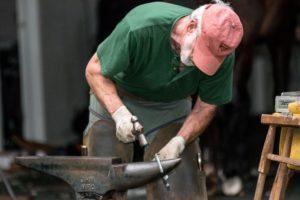
There is no structure on the horse that is as susceptible to injury, disease, or “wear and tear” than the equine foot. Proper, timely hoof care can often make the difference between a sound performance horse and one with chronic lameness. Some of the problems that Dr. O’Grady consults on include:
- Hoof Diseases
- Laminitis
- Severe Infections
- Advanced White Line Disease
- Therapeutic Horseshoeing
- Hoof Wall Defects
- Juvenile Orthopedics
Equine podiatry requires extensive knowledge of hoof anatomy, physiology, biomechanics and diagnostic imaging, as well as the farrier skills necessary to implement specialized shoeing. The combination of being educated as both a veterinarian and a professional farrier allows Dr. O’Grady to treat each foot problem with an understanding of the medical physiology and the mechanics involved. This blending of the two professions allows him to comprehensively diagnose, treat, and design a maintenance plan for a variety of foot conditions using medical therapy as well as therapeutic farriery. Dr. O’Grady also works together with referring veterinarians on difficult cases to discuss and assist with a plan that works for all parties.
Diagnostic Imaging for Equine Podiatry Cases
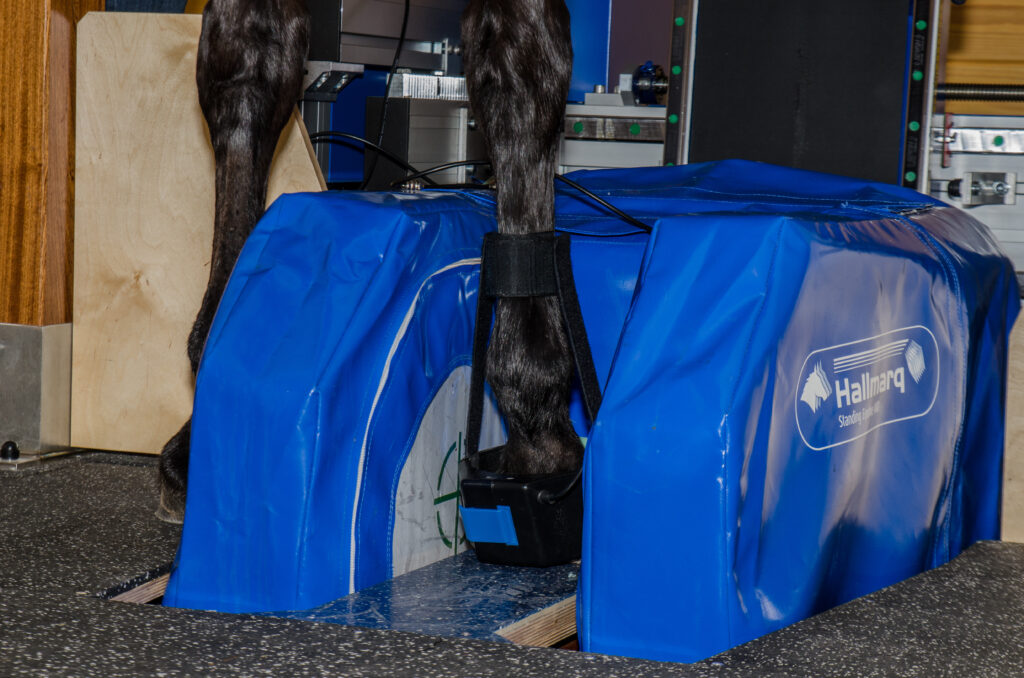
The advanced imaging equipment at Palm Beach Equine Clinic, in combination with Dr. O’Grady’s expertise, allow for comprehensive diagnosis and treatment of all hoof-related conditions. Palm Beach Equine Clinic offers a Hallmarq standing MRI that can provide a detailed diagnosis of any foot issues. Medical therapy, such as surgery and various medications, are often combined with therapeutic farriery for the best possible results. Dr. O’Grady’s methodology centers around using the basic principles of farriery, and when necessary, combining these principles with advanced technology and improved farrier products available on the market.
Equine podiatry consultations can be used for a variety of complicated hoof conditions where the problem is severe, chronic, and non-responsive to the present treatment. Hoof problems can include severe injuries, acute or chronic laminitis, hoof wall defects (non-healing quarter or toe cracks), hoof capsule distortions (club feet, long toe under-run heels), and severe hoof disease (infections, WLD, canker). There are many hoof-related problems that benefit from the advanced technology and farrier techniques available today.
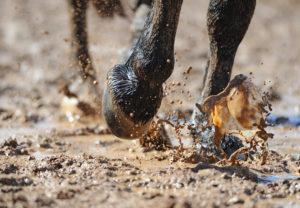
Thrush, rainrot, and scratches are problems that most equestrians have probably encountered, but in the hot, wet climate of South Florida, these issues can incessantly plague horses and their owners. While different in their presentation, thrush, rainrot, and scratches have a lot in common. For horse owners, there are several problems that arise due to environmental factors or predisposing conditions, but these issues can easily be prevented or treated with proper care and management.
This month, Palm Beach Equine Clinic’s Dr. Bryan Dubynsky shared his expertise on the causes, treatment, and prevention of thrush, rainrot, and scratches.
What is Equine Thrush?
Thrush is an infection within the horse’s hoof, most commonly caused by bacteria that invade the deeps clefts or grooves (known as sulci) of the frog. Fusobacterium Necrophorum is the common bacterial culprit, which naturally occurs in the environment, especially in wet, muddy, or unsanitary areas. Thrush bacteria thrives where there is a lack of oxygen.
Causes of Equine Thrush
Some horses are predisposed to developing thrush due to conformation, such as a rather high heel or deep sulci, or a narrow or contracted heel. The bacteria will manifest in horse’s feet that are not picked out regularly, or standing in muddy, wet environments, including paddocks or stalls that have not been cleaned properly.
Thrush can typically be first identified by the odor. The frog will have a strong, rotten odor and become spongy. Visually, the frog can even exudate (oozing) pus.
Treating Equine Thrush
The treatment for Thrush is fairly simple as it is very sensitive to oxygen. The most important thing is to have your vet or farrier trim or debride the frog to expose areas to the air. It is best to keep the hoof clean and dry. Adding a common detergent to the Thrush areas, such as Betadine or any commercial product (Thrush Buster, Coppertox, etc.) will help to kill the bacteria. Most importantly, if the horse is not removed from those predisposing environmental factors, treatments can be ineffective.
Maintaining a level of activity for our equine partners will increase blood flow to the feet and promote health to the area. Horses found in dry environments with ample space to move typically do not suffer from Thrush. The activity of horses moving keeps the frogs healthier. The more blood flow you have in the foot, the less chance that infection is able to manifest.
Thrush is not guaranteed to cause lameness. In extreme rare cases, Thrush can penetrate deeper and cause an infection in deeper tissue or even in the coffin bone. When in doubt, always contact your veterinarian.
What is Equine Rainrot (Dermotophilus Congolensis)?
Rainrot is caused by a naturally occurring bacteria named Dermotophilus, which produces spores. rainrot is recognized as scabby, scaly, crusty spots on areas of the horse that have been exposed to rain. It is commonly seen on the neck or across the back (dorsum). rainrot is not typically apparent on the legs or under the belly.
Causes of Rainrot

When there is a break in the skin, which can be even as simple as an insect bite, a surplus of rain on the skin washes away the natural protective oils. Once the skin is stripped of the natural protective layer or any sort of trauma to the skin barrier occurs, those spores are able to invade the deeper dermis skin layers. The spores penetrate into the deeper layers of the dermis, and the body reacts by sending white blood cells and proteins to fight the invaders. This reactive response causes the small pustules, scabs, and bumps to form.
Similar to thrush, rainrot is an environmental issue. It is most commonly seen in warm areas with high humidity, excess rain, and insects. The most important prevention is to keep horses out of the rain for prolonged periods of time. A horse can be out in the rain for short periods of a day or two, but if it is constantly in hot and rainy conditions with biting insects, more than likely the horse will develop rainrot.
Treating Equine Rainrot
Dr. Dubynsky emphasizes that topical products are not worth anything if the horse is not removed from the environmental factors. Once you remove the environmental factors, a keratolytic agent (something that exfoliates keratin), such as Benzoyl Peroxide or an antibacterial shampoo will help the skin heal. He also cautions that if the horse does have scabs, you do not necessarily want to pick the scabs off because then you are just leaving open skin without protection for more bacteria to invade. The most important tip to healing is to keep the area dry.
In very rare, severe cases of rainrot, it is best to contact your veterinarian to put the horse on antibiotics. If left untreated, and the horse is not removed from the environmental causative factors, the infestation can lead to Staphylococcal Folliculitis; a type of Staph bacteria that will invade the hair follicles and cause a more serious situation.
What are Equine Scratches?
Scratches is a generic term for many different ailments. The definition of scratches can be a bacterial, fungal, or viral dermatitis or inflammatory condition of the pastern or fetlock. It is defined as a chronic Seborrheic Dermatitis (flaking of the skin), characterized by hypertrophy (enlargement of tissue from an increase in cells) and exudation (escape of liquid from blood vessels through pores or breaks in the cell membranes) on the rear (palmar plantar) surface of the pastern and fetlock.
Causes of Equine Scratches
There are certainly predisposing factors for Scratches, including the same environmental factors that cause Thrush or Rainrot. Predisposing factors for Scratches include horses that are bathed often or stand in wet conditions all the time. Horses that have an excess amount of hair on their legs, especially draft horses, also develop scratches easily because the hair traps dirt and moisture on the skin.
Scratches can develop in horses that are bathed too often such as the intensely managed show horse. The show horse is desired to be very clean, which can mean several baths a day. This will strip away the natural protective oils and barrier of the dermis, which allows bacteria or fungi to invade. When moisture penetrates the skin, it causes inflammation reacting with heat, redness, pain, and loss of protection to keep bacteria out.
Prevention and Treatment of Equine Scratches
The most effective first step for prevention and treatment should be to remove the environmental predisposing factors. Removing excess hair during the humid months and keeping horses clean and dry to the best of your ability will reduce the probability of developing an infection. Bathing horses once a day with Betadine or antifungal/antibacterial shampoo will help to clear the infection. Be sure to leave the shampoo on for 20 minutes for all of the medicine to penetrate, rinse thoroughly, and make sure the horse is completely dry. In order to effectively treat the bacteria, horses should be completely towel or air dried before returning to their stalls or paddocks.
As always, contact your veterinarian immediately if there appears to be deeper infection present, or you would like more detailed information on how to treat and prevent these bacterial infections. For more information, contact Palm Beach Equine Clinic at 561-793-1599.



